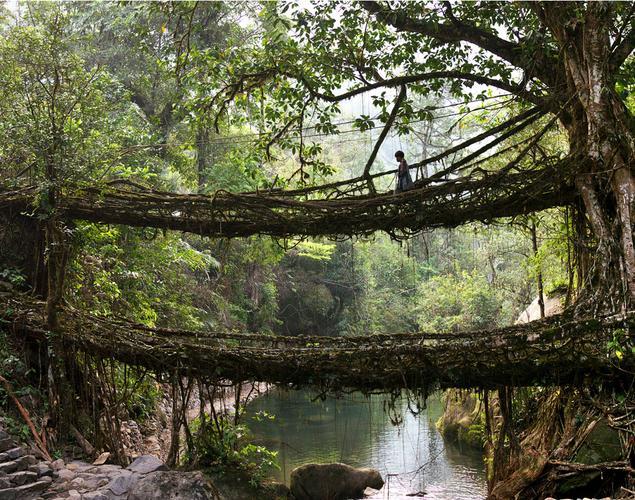February 3, 2013
Meghalaya, in the far northeast of India, is a largely Christian region that sees few foreign tourists. The region is especially good for women, who hold much of the power.

The hills of Meghalaya
February 3, 2013
Meghalaya, in the far northeast of India, is a largely Christian region that sees few foreign tourists. The region is especially good for women, who hold much of the power.

The hills of Meghalaya
"I'm the supreme power in my house," declared Dave the shopkeeper. "That is certain." Behind him his wife and female relatives giggled. He turned and glared until they agreed that he was definitely the boss.
The women had good reason to snigger. The shopkeeper does not own the shop – it belongs to his wife. He has four children – three sons and one daughter. But none of them went by his family name: they all had his wife's surname, and the daughter would inherit the shop.
The couple lives in the Indian state of Meghalaya, one of the few places in the world with a matrilineal system, where women own land and property – and men put on a brave face.
Never heard of Meghalaya? Don't worry, you're not a wannabe Ukip member. It's in the far, far northeast of India and is one of the Seven Sisters, the seven states of India sandwiched between Bangladesh, Bhutan and Burma. The sisters are linked to the rest of India by a sliver of land just 14 miles wide at its narrowest point.
Meghalaya is also overwhelmingly Christian – European missionaries having swarmed here on a souls-grab from the mid-19th century onwards.
It sounded like an intriguing corner of India, and one visited by few foreign tourists. You'll struggle to find a package tour there – but it is easy to put together your own trip. My friend Nick and I flew to Kolkata and took the 18-hour sleeper train north, along the border with Bangladesh, hanging a sharp right as the Himalayas came into sight, then pulling into Guwahati, in the state of Assam.
As soon as we got a taxi out of Guwahati and crossed into Meghalaya, the people we saw around us changed, becoming lighter-skinned and almond-eyed. We were in tribal territory, the land of the Khasi people. The colorful signs on the Lorries tearing past us on the twisting road appealed to Jesus, not Shiva, for good luck or salvation.
As the road climbed into pine-covered hills dotted with pretty lakes, the Europeans' nickname for the area, the Scotland of the East, started to make sense. We changed taxi in Shillong, the state capital, and made for the town of Cherrapunjee. Pressing on, along an impossibly narrow road with terrifying drops, we finally got to our hotel, more than 24 hours after leaving Kolkata.
The Cherrapunjee Holiday Resort sits at nearly 1,000m, with hills in every direction except the south, where the slopes fall sharply away to the plains of Bangladesh. Clouds were building up over these plains, a clue to Cherrapunjee's big claim to fame: it is the wettest place in the world, with 12m of rain a year, 20 times what London sees. The annual monsoon makes the British summer of 2012 look like a toddler's teary temper tantrum.
Posters with meteorological facts covered the walls of the dining room, explaining how, from June to October, clouds would march from the south towards the hills where they would unceremoniously dump their load. Years of ridiculous rainfall figures were listed like a badge of honor. There were also slightly sniffy references to a village, Mawsynram, a few miles away which in the past couple of seasons had posted higher rainfall.
I don't own a pair of wellies, let alone a Kevlar-reinforced brolly, so we had timed our visit for the dry months.
I woke up jet-lag early the next day and walked to the nearby village just as the sun was rising and households were stirring. A teenager, crucifix around his neck, was on his knees on the roof of his home murmuring his prayers, while his younger sisters, already in school uniform, were in the courtyard reciting their times tables. They lost their way when they saw me and shyly said good morning. I wandered past a stall as a man sleepily lifted its shutters. This was Dave (Phanbuh), who introduced himself and explained that his great-grandfather had been a British soldier stationed here in the 1920s. He fielded my questions about the matrilineal system, and continued to insist he was the master of the household, despite the laughter from the women.
"It is good for the women, but not for the men," he finally admitted, ruefully.
I struggled to stifle a snigger when he said his wife's name was Fullmerry. Crazy names rule here, a legacy of the missionaries' work. I was told that children now are just as likely to be named after the latest gadget as a saint, but though I asked the names of people I met across Meghalaya, I sadly never came across a toddler called iPad mini.
By mid-morning we were on a walk to the valley floor, led by our young guide, Don. Five hundred steps into our 2,000-step decent he revealed he had a girlfriend, Jubilee. By 1,000 steps he said he wanted to marry her. By 1,500 steps he was asking my advice about how to ask her father for permission. Villages we passed often had fewer than a dozen homes but most had a simple church, either Catholic or Protestant, sometimes one of each.
By the time we reached the valley floor I had been convinced that Don would make a great son-in-law. We had reached a small stream. Of course, come monsoon, this would become a torrent. How to cross it? How to trade? How to find a wife? Marrying within your clan is strictly prohibited. The Khasis invented a spectacular solution to the problem.
We followed the path, turned a corner and entered Middle Earth. There before us was something from the set of The Hobbit, a bridge made out of a living tree. Its twisted roots formed the base, sides and supports of the 20m span across the river. It looked completely natural and completely insane at the same time, as if the tree had decided one day to go on an unexpected journey. I half-expected to see Bilbo Baggins scuttle across on his way to Rivendell.
In such a wet world a wooden bridge would soon rot, so for hundreds of years villagers have trained the roots of rubber trees across rivers. It could take 10-15 years for the bridges to become strong enough to be used.
This bridge was particularly ambitious because it was a double-decker, one span above the other. I gingerly stepped on to the lower crossing, about 5m above the river bed, but the lattice-work of roots was solid. There were even big flat rocks laid on the base to make a smoother walking surface. My biggest fear was that one of the sinuous roots I was using as a handhold might turn out to be a sinuous snake.
The bridges are still used – I watched as a tiny elderly woman carrying a giant basket walked nimbly across. We crossed more bridges but none was as impressive as the double-decker. It was a shame to see a new wire suspension bridge beside an old and dangerous root bridge in a couple of places.
I stripped off for a swim in a pool before the long, sweaty climb back up to the hotel as Don explained that the matrilineal system was changing, and some sons would now inherit a share of the family wealth. I wished him well with his Jubilee plans.
But if that Khasi tradition is weakening, one foreign import is going from strength to strength. The Welsh Presbyterians spotted a gap in the proselytizing market when they looked about the British empire in the 1830s. These hills had been largely untouched by other missionaries when the Reverend Thomas Jones arrived in Cherrapunjee in 1841.
Legend has it that the Khasi lost their written language – in a great flood, obviously. Once Jones had got over the shock of finding a place wetter than mid-Wales, he learned to speak Khasi and compiled an alphabet and a dictionary in Roman script – choice examples are slap (rain) and shit (hot).
Presbyterianism thrived and the Khasis got back their written language, which prompted a flourishing of writing that continues today. Unfortunately Jones's story did not end happily. Weakened by fever, his wife died in childbirth. He fell out with the church elders after marrying a 15-year-old and was forced to leave the hills. He died of malaria in 1849, aged 39.
Around 500,000 Khasis are now Presbyterians, 20 times more than in Wales itself. Nick and I headed into Cherrapunjee to find Jones's church. It was market day, and the biggest section of the market was devoted to betel nut and leaves. The mouths of men, women and children were stained red and there was spat-out juice splattered up walls everywhere.
I wandered into what looked like a Presbyterian church. It took a passing taxi driver, Aloysius, to gently explain that I was in a Catholic church and to offer to take me to Jones's church. It stood on the outskirts of town, as simple as the churches I'd seen on our walk. I tried to imagine Jones at the lectern, preaching to the Khasis, telling them to give up their local firewater or face damnation.
Aloysius delivered me to the home of a church elder. I knocked uncertainly and an elderly woman waved me inside. Forget Middle Earth – this time I'd entered middle Wales. The elder, Willis Knight, sat me down in the front room, antimacassars and all. There was a coffee table book of Welsh landscape photographs and a display case full of Welsh ephemera – a snow globe of Cardiff, a pair of sunglasses emblazoned with the Welsh flag, photographs of missionaries in stiff collars.
Mr Knight explained sadly that he had never been to Wales. "I almost went many years ago, but something happened," he said quietly. "I'm an old man and I won't go now." He and his wife offered us tea, but Aloysius, a Catholic, was hovering.
He dropped us back in town, where a series of booths had now opened, each with a man behind a counter, and numbers scrawled on a blackboard. Crude, 18-inch wooden arrows with clunky metal heads were for sale in a shop on the marketplace. The owner explained that the local sport was archery, and betting on the big contest in Shillong was the local passion.
The next day, back in Shillong, I placed a quid on 9 and 19 for that day's shootout and, with odds of 80/1, was looking forward to a slap-up meal in Shillong's finest restaurant that night.
In a street of car repair workshops we were pointed down an unpromising alley and through a gate. The archers were already in a semi-circle and one explained that there would be 50 archers who each had four minutes to shoot 30 arrows into a drum about 15m away. On a signal they were off, dozens of arrows thwacking into the target. I soon realized there was little or no skill required. The archers looked bored, stopping to have a fag or send a text message between arrows.
The drum looked like a porcupine after the time was up. Game over? Nope, this was where the real point of the affair became clear. The arrows were pulled from the target, placed in bunches of 10 in front of an earnest panel of men and counted. The last two digits of the total would be the winning number. There were 902 arrows in the target, so 02 was the winning number. Dozens of men got on to their mobiles and relayed the number to betting booths around Meghalaya and beyond.
It was a lottery! Pulling a number out of a hat would have achieved the same result – but without the spectacle and definitely with more allegations of cheating. No slap-up meal for us. Nick and I had to make do with a beer in a dodgy Chinese-run bar straight out of Indiana Jones, with regulars quickly drinking themselves into oblivion with whisky after whisky. Clearly 02 wasn't their lucky number either.
We flew back to Kolkata, where I had one final place to visit. The Scottish cemetery is a forlorn place. Thieves have stripped the marble from the graves of soldiers and East India Company men. Only one was pristine. The grave had recently been refurbished by Khasi Presbyterians. He was a long way from his birthplace, and from the place he made his home, but the Rev Thomas Jones had not been forgotten.
This article originally appeared on guardian.co.uk
















































































































